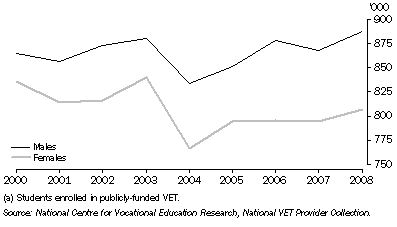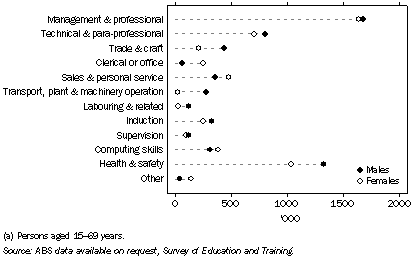VOCATIONAL EDUCATION AND TRAINING (VET)
There are almost 5,000 registered training organisations in Australia. While there are around 3,700 private training providers of VET, most VET students are engaged with publicly-funded training providers. These are predominantly government administered TAFE colleges or institutes. Other publicly-funded VET can be provided by higher education institutions, secondary schools and colleges, agricultural and technical colleges, and adult and community organisations. Private providers of VET can include private training organisations, business colleges, industry associations, adult and community organisations and employers.
VET providers offer a wide range of subjects and programs including traditional trades, advanced technical training, para-professional and professional studies as well as basic employment and educational preparation. While formal VET study provides skills and nationally recognised qualifications for employment, students may complete only one or two subjects to gain specific skills, without completing a full qualification, if that is their choice.
Students and courses
Overall, the number of students in publicly-funded VET in 2008 declined by 1.5% from 2000. Over this period, male student numbers increased by 2.6% while female student numbers decreased by 3.5%. The number of publicly funded VET students increased by 2% between 2007 and 2008 (graph 12.12).
12.12 VET STUDENTS(a)

During 2008, there were 1.7 million students enrolled in publicly-funded VET courses with 52% being males (table 12.13). Enrolments by persons aged 19 years or younger increased by 3%, between 2007 and 2008. All age groups showed an increase in enrolments from 2007 to 2008 for both sexes with the exception of females in the 40-49 age group. In 2008, 58% of male students and 48% of female students were under 30 years of age.
12.13 VET STUDENTS(a), Vocational and preparatory courses(a) |
|
 | 2007
|  | 2008
|
 | Males | Females | Persons(b) |  | Males | Females | Persons(b) |
| Age group (years) | '000 | '000 | '000 |  | '000 | '000 | '000 |
|
| 19 years and under | 247.6 | 196.3 | 444.2 |  | 254.9 | 201.6 | 456.7 |
| 20 to 24 years | 163.4 | 112.0 | 275.6 |  | 167.1 | 112.1 | 279.3 |
| 25 to 29 years | 90.6 | 72.7 | 163.5 |  | 94.7 | 75.8 | 170.7 |
| 30 to 39 years | 147.1 | 140.9 | 288.4 |  | 149.7 | 141.0 | 291.0 |
| 40 to 49 years | 113.0 | 144.5 | 257.9 |  | 113.8 | 144.2 | 258.3 |
| 50 to 59 years | 68.8 | 85.0 | 153.9 |  | 69.7 | 87.5 | 157.4 |
| 60 years and over | 28.1 | 31.1 | 59.4 |  | 29.6 | 34.0 | 63.7 |
| Not stated | 9.3 | 11.7 | 22.1 |  | 8.1 | 10.5 | 19.4 |
| Total students | 868.0 | 794.2 | 1 665.0 |  | 887.5 | 806.7 | 1 696.4 |
|
| (a) Includes all VET delivery by TAFE and other government providers, multi-sector higher education institutions, registered community providers and publicly funded delivery by private providers. Fee-for-service VET delivery by private providers has been excluded. School students undertaking VET in schools have also been excluded. A student is an individual who was enrolled in a subject or completed a qualification at any time in 2008. |
| (b) Includes 'sex not stated'. |
| Source: National Centre for Vocational Education Research, data available on request, National VET Provider Collection. |
VET courses are classified according to specific fields of education. Table 12.14 shows the number of course enrolments in 2008 in 11 fields of education and for mixed field programs. Since students may be enrolled in more than one VET course, the number of course enrolments is greater than the total number of students. In 2008, there were 2.1 million course enrolments taken up by 1.7 million students.
Some 21% of enrolments in VET courses in 2008 were in the Management and commerce field, while 17% were in each of Engineering and related technologies, and mixed field programs. A further 11% of enrolments were in Food, hospitality and personal services.
Male enrolments were most dominant in the education fields of Architecture and building (93%); Engineering and related technologies (89%); Agriculture, environmental and related studies (75%); and Information technology (71%). In contrast, females were in the majority in the fields of Society and culture (74%); Management and commerce (63%); Food, hospitality and personal services (62%); Creative arts (60%); Health (59%); Education (59%); and Natural and physical sciences (58%).
12.14 VET COURSE ENROLMENTS(a), Vocational and preparatory courses - 2008 |
|
 | Males | Females | Persons(b) |
| Field of education | '000 | '000 | '000 |
|
| Natural and physical sciences | 3.1 | 4.3 | 7.4 |
| Information technology | 29.9 | 12.2 | 42.0 |
| Engineering and related technologies | 305.1 | 35.7 | 340.9 |
| Architecture and building | 131.8 | 9.8 | 141.7 |
| Agriculture, environmental and related studies | 63.1 | 20.5 | 83.7 |
| Health | 43.1 | 61.3 | 104.4 |
| Education | 24.1 | 35.0 | 59.2 |
| Management and commerce | 154.4 | 266.7 | 421.4 |
| Society and culture | 55.0 | 153.8 | 209.0 |
| Creative arts | 20.8 | 31.3 | 52.1 |
| Food, hospitality and personal services | 84.2 | 135.1 | 219.4 |
| Mixed field programs | 158.9 | 186.7 | 346.0 |
| Total enrolments(a) | 1 073.6 | 952.1 | 2 027.3 |
|
| (a) Includes all VET delivery by TAFE and other government providers, multi-sector higher education institutions, registered community providers, and publicly-funded delivery by private providers. Fee-for-service VET delivery by private providers has been excluded. School students undertaking VET in schools have also been Excluded. |
| (b) Includes 'sex not stated'. |
| Source: National Centre for Vocational Education Research, data available on request, VET Provider Collection. |
Apprenticeships and traineeships
Of the 426,700 apprentices and trainees in training at 31 March 2009, about two-thirds were males (66%). Some 47% of all apprentices and trainees were in the Technicians and trades workers occupational group. Within this occupation group, Automotive and engineering trades workers represented 28%, followed by Construction (27%) and the Electrotechnology and telecommunications (17%) sub-groups. Females in these three sub-groups represented only 2% of all female apprentices and trainees in 2009 (table 12.15).
Most of the Technicians and trades apprentices and trainees in 2009 were male (88%). Construction trades workers notably comprised 99% males. In contrast to Technicians and trades workers, the proportion of males among the 225,700 non-trades apprentices and trainees was less than that of females (47% males and 53% females).
The number of apprentices and trainees reduced slightly from March 2008 (427,000) to March 2009 (426,700). Over the same period, apprentices and trainees in the non-trades groups of Managers and Professionals increased by 26% and 16% respectively.
12.15 APPRENTICES AND TRAINEES, In-training - 31 March 2009 |
|
 |  | Males | Females | Persons |
| Occupation(a) | '000 | '000 | '000 |
|
| Managers | 2.3 | 5.4 | 7.7 |
| Professionals | 6.3 | 2.5 | 8.8 |
| Technicians and Trades Workers |  |  |  |
 | Engineering, ICT and Science Technicians | 3.8 | 1.1 | 4.8 |
 | Automotive and Engineering Trades Workers | 54.9 | 1.1 | 56.0 |
 | Construction Trades Workers | 53.7 | 0.6 | 54.3 |
 | Electrotechnology and Telecommunications Trades Workers | 34.4 | 0.7 | 35.0 |
 | Food Trades Workers | 14.1 | 5.0 | 19.1 |
 | Skilled Animal and Horticultural Workers | 5.8 | 2.0 | 7.8 |
 | Other Technicians and Trades Workers | 9.4 | 14.5 | 23.9 |
 | Total Trades Workers | 176.1 | 24.9 | 201.0 |
| Community and Personal Service Workers | 14.0 | 34.4 | 48.3 |
| Clerical and Administrative Workers | 22.4 | 36.6 | 59.1 |
| Sales Workers | 16.6 | 28.4 | 45.0 |
| Machinery Operators and Drivers | 29.5 | 4.3 | 33.8 |
| Labourers | 15.6 | 7.4 | 23.0 |
| Total | 282.8 | 143.9 | 426.7 |
|
| (a) Classified according to the ABS Australian and New Zealand Standard Classification of Occupations (ANZSCO), First Edition, 2006 . |
| Source: National Centre for Vocational Education Research, National Apprentice and Trainee collection. |
Staff
Table 12.16 provides estimates of the number of teachers working in TAFE and other VET institutes in 2008-09. Of all VET teachers 61% were employed full time. The majority of full-time VET teachers were male (69%). In contrast, 56% of part-time VET teachers were female.
12.16 VET TEACHING STAFF(a)(b) - 2008-09 |
|
 | Full-time staff(b) | Part-time staff | All teaching staff |
 | '000 | '000 | '000 |
|
| Males | 16.8 | 6.5 | 23.3 |
| Females | 7.9 | 9.7 | 17.5 |
| Persons | 24.7 | 16.2 | 40.8 |
|
| (a) Annual average of quarterly data. |
| (b) Refers to persons working 35 hours or more in the survey week. |
| Source: ABS Labour Force, Australia, Detailed, Quarterly, Aug 2009, (6291.0.55.003). |
Training courses
According to the 2005 ABS Survey of Education and Training, 5.3 million people aged 15-69 years (54% of whom were male), completed one or more work-related training courses in the previous 12 months. Of the 11.2 million work-related training courses completed, 30% were in the Management and professional field. Other commonly reported fields of training were Health and safety (21%), and Technical and para-professional (14%). Graph 12.17 shows the fields of work-related training courses completed by males and females in 2005.
12.17 Work-related training courses completed(a), Field of training
- 2005

 Print Page
Print Page